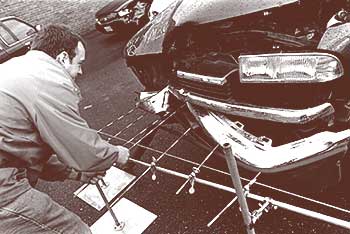 |
|||||||||
|
Research Feature Stories: Other News: |
Physicians Address Causes of Injuries
How can you reduce the risk of being killed in a motor vehicle crash by 86 percent? Buckle up, using both lap and shoulder seatbelts, say UW researchers at the Harborview Injury Prevention and Research Center (HIPRC).
The lap and shoulder belt recommendation, published in the Journal of the American Medical Association, is just one of many injury-related studies released by HIPRC since its inception in 1985. The center, directed until 2000 by Dr. Fred Rivara, the George Adkins Professor of Pediatrics and adjunct professor of epidemiology, was formed as a complement to the Northwest Regional Trauma Center at Harborview Medical Center in collaboration with the UW Schools of Medicine and Public Health.
The HIPRC is one of 10 interdisciplinary research centers funded by the Centers for Disease Control and Prevention’s National Center for Injury Prevention and Control.
 |
Severe or common injuries, such as the ones produced by car crashes, are studied by the team at the Harborview Injury Prevention and Research Center. |
More than two-thirds of the HIPRC researchers also see patients in the UW system. All the researchers have the opportunity to monitor patient injuries in the emergency room, intensive care and other hospital units.
“We focus on injuries that are severe or common,” said Dr. David Grossman, professor of pediatrics and current HIPRC director. “Because our researchers come from so many different medical and scientific fields—surgery, pediatrics, orthopedics, epidemiology, and more—we can address problems from a truly interdisciplinary perspective.”
Much of the HIPRC research concentrates on injuries as a major medical problem of otherwise healthy children. Rivara’s work in particular has helped increase public awareness of the importance of wearing bicycle helmets. The HIPRC was instrumental in organizing a series of public awareness campaigns, helmet discounts, and helmet-distribution programs for the needy. As of May 2001, there are 18 state laws requiring minors to wear helmets when bicycling. Rivara has recently suggested the study of helmets in other fast-action sports, such as skiing and snowboarding.
Rivara also recommends children weighing under 80-pounds use booster seats in automobiles to supplement adult-sized lap belts and shoulder harnesses. If a child cannot sit up straight with the child’s knees bent over the edge of an automobile seat, then an adult-sized seatbelt does not offer sufficient protection, according to HIPRC analyses.
Other studies at the HIPRC are addressing questions regarding domestic violence victims, pedestrian safety, child bereavement, footwear and falls, firearm storage, and smoke detector effectiveness. HIPRC researchers are working with other organizations interested in injury prevention including the Washington State Department of Social and Health Services, the Division of Health of the Seattle/King County Health Department, Group Health Cooperative, King County Medical Examiner’s Office, Seattle Police Department, Washington State Medical Association, and the Washington Traffic Safety Commission.
“Do trigger locks reduce the risk of suicide? Are some types of smoke detectors more likely to be disconnected because of nuisance alarms?” asked Grossman. “These are questions that nobody knows the answers to—yet. What we learn in our research may help save lives.”
|
| UW AMC Medical Center | UW School of Medicine | Harborview | UW MC | Search UW AMC | UW Home | Contact Us | ©2001-2002, University of Washington Academic Medical Center. All rights reserved. Please honor our copyrights. |
|